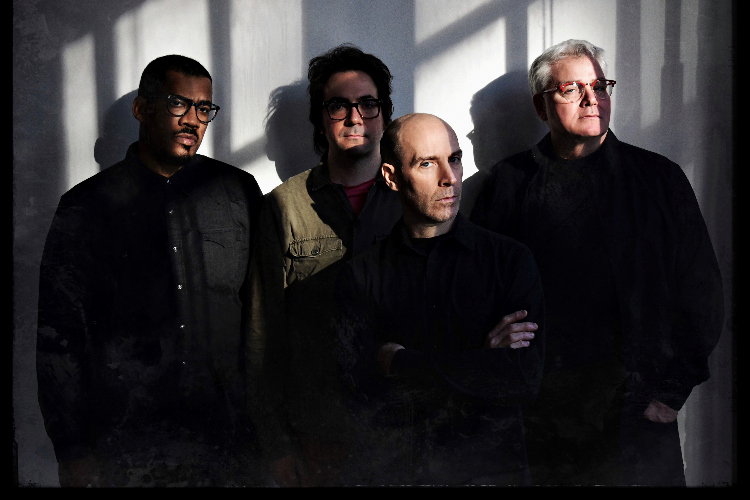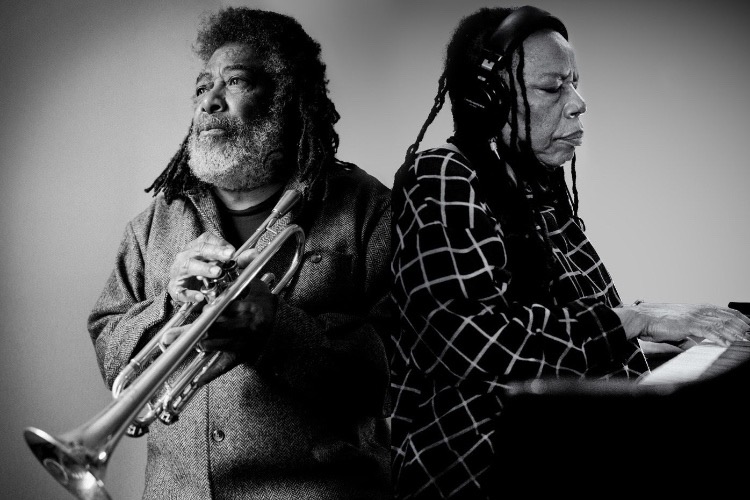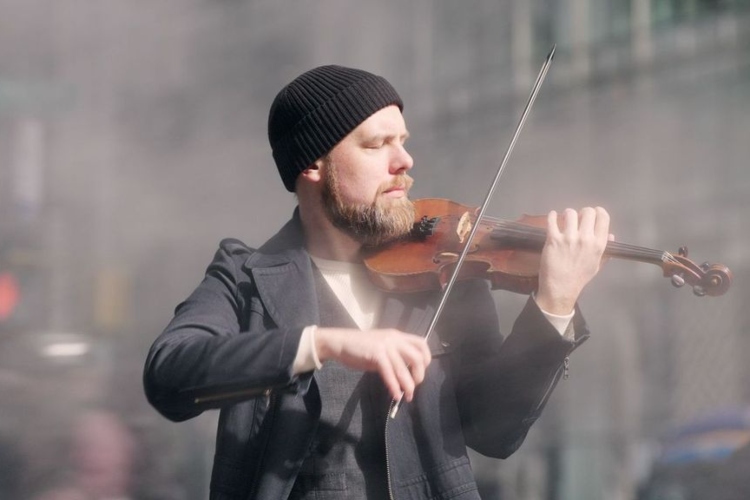Collaborative High Intensity : A Conversation with Anthony Pirog on ‘The Messthetics and James Brandon Lewis’
|
Getting your Trinity Audio player ready...
|
Jazz and punk have long had a fascinating relationship. Mixing both styles dates back to at least fifty years ago, with punk powerhouse The Stooges incorporating jazz-influenced saxophone solos on “L.A. Blues” and the title track on Fun House (Elektra, 1970). Actually, many of the early punk icons were fans of jazz music, particularly the grittiness and edge exhibited by their avant-garde counterparts. Then there was the Downtown no wave movement, where John Zorn, James Chance and the Contortions, and Bill Laswell’s Massacre and Material and others further deepened connections between the two genres. The Lounge Lizards were the first group to label themselves “punk jazz” – though leader John Lurie also used titles like ‘fake jazz.’ Henry Rollins has praised the work of Matthew Shipp and worked with Charles Gayle. The trend continues into the present era with groups like Marc Ribot’s Ceramic Dog. In a sense, DC-based the Messthetics is a part of this lineage. But, as shown on The Messthetics and James Brandon Lewis and our conversation with the group’s guitarist, Anthony Pirog, that is only part of their story.
For one thing, the Messthetics comes from a history of merging and blurring different genres. Two-thirds of the trio – Joe Lally and Brendan Canty – come from the highly influential punk band Fugazi. In an era where hardcore punk was the norm, Fugazi dared to step away from that approach and, instead, incorporate elements of funk, reggae, and other styles into their music. In the process, they broadened the scope of punk music, endearing an entire generation of punk rockers to their work. The remaining member of the Messthetics, the DC based virtuoso Pirog, is well-versed in his home city’s music history and similarly untethered to genre norms. His past output has explored classical, jazz, ambient, harsh noise, electronic music, and rock in distinctly unique ways. Add the commandingly chameleonic saxophonist James Brandon Lewis to the proceedings, and it should come as no surprise the result is an album that builds off of its punk and jazz roots but expands to other territories, as well.
While the Messthetics and Lewis have collaborated before, including on the latter’s Eye of I (Anti-,2023), the setting of an entire album lets their wide interests emerge more fully than that reflected in past output. “Emergence” begins with a recurring – almost electronic-sounding – guitar riff that is disorientingly shimmery. The piece grows heavier and edgier before erupting into a firey free saxophone solo. “Three Sisters” is built around a dub groove. Lally’s “Railroad Tracks Home”, built around a Frisellian countrified blues, continually shifts between dark and light.
The Messthetics and James Brandon Lewis – hopefully, the first of many albums by the extended group – showcases incredible conversations that can occur only among high-intensity open-minded artists who put their all into their craft. Instead of trying to confine each other to a set range of ideas, each member of the quartet pushes one another to keep going further out. As a result, the recording often presents compelling creative paradoxes. The music is surprisingly approachable with catchy melodies yet makes liberal use of free improvisation. The grooves make you want to move, yet they are complex and require intellect and maturity for full appreciation.
We sat down with Anthony Pirog to discuss the origins of the Messthetics and the new album.
PostGenre: How did the Messthetics come together?
Anthony Pirog: Before the Messthetics, I was working on all kinds of projects. I had a surf band called The El Reys. I was doing solo improv stuff. I had quartets and trios. And I had a group with my wife Janel [Leppin] called Janel and Anthony.
Janel and I shared a bill with Brendan [Canty] and another bass player. Brendan told me he had previously come out to see me perform in this Danny Gatton tribute concert. I asked Brendan if he liked Danny Gatton, and he told me that he loved Danny’s music. And from there, Brendan and I really hit it off. At the time, Brendan was working on a film and asked Janel and me if we could do a live soundtrack recording for it.
But really, the Messthetics started because Joe [Lally] had just come back to the US from living in Italy and was trying to put together a trio for a tour. Brendan suggested that I come in and play with him and Joe to see if the three of us would work as a trio. We did one rehearsal together where we were just improvising off of bass lines Joe had written and he was singing. It went well, but the tour ended up not happening. After that, I waited a few months and built up the courage to ask Joe and Brendan if I could hire them to be the rhythm section for a recording I wanted to do. And they said, “Well, why don’t we just start a band?” And that’s how the Messthetics came to be.
PG: You mentioned having to build up the courage to ask them. Were you a fan of Fugazi before you started working with Brendan and Joe?
AP: Absolutely. I love being from Washington, DC. The original music from here is very important to me. That scene and people like Danny Gatton and Roy Buchanan have all been very important to me. I’ve tried to honor them in any way I can. And that is one of the things I love about the Messthetics; you can hear our DC roots in the music.
PG: Were you ever concerned that some element of those roots might be lost in adding James Brandon Lewis to play with the group? James is an incredible artist but is from Buffalo originally, not DC. Though he studied at Howard University, he may not be as connected to DC as the three of you.
AP: No. James and I have known each other and have been friends for ten years now. We met at a William Hooker recording session. William asked me to come up to New York to record. Jon Irabagon was there. So was James, though I did not know him at the time. Luke Stewart, who I’ve known for a long time, was there too. James and I hit it off immediately and, of course, have worked together on different projects since.
PG: What do you feel you learned the most from working with William Hooker?
AP: Well, the first time I played with him was down here in DC. We played at Bohemian Caverns and Transparent Productions put the show together. I was pretty nervous about it.
What I learned from him was the need to be energetically strong when playing live. When he would start a set, the music always felt huge. Working with him, I felt like I needed to match the size of his sound.
We also did a couple of trio performances with Luke Stewart at Twins in DC. It started with William taking a solo, then Luke taking a solo. Both of them had huge statements. And so, when it was my turn, I knew I needed something that would match their weight. That’s something I think about when I think about my time with William.
PG: You mentioned a minute ago other projects with James. You were part of his Unruly Manifesto band, right?
AP: Yeah, like I said, James and I hit it off immediately when we were working with William. He ended up asking me to play as a featured guest with his trio. Then he asked me to play with his Unruly Manifesto band for Winter Jazzfest. We also recorded that group and, throughout the entire process, James was very generous with me in terms of letting me be myself in the music. So, when the Messthetics were booked for Winter Jazzfest, I asked James to collaborate with us. I felt like he would be a good energetic match for the overall sounds of the band.
PG: Do you feel adding James to the Messthetics changes the dynamic of the group?
AP: Absolutely. The first thing that I think about it is that it’s nice to share the space with somebody else. It’s pretty demanding for me when we’re a trio. Adding someone else to the group lets me feed off of other soloists or take the role of an accompanist. And that is nice in terms of pacing in a performance.
But as far as James specifically, I greatly enjoy playing with him and our sounds blend together very well. I use some pretty extreme fuzz pedals when I’m playing lines with him and I think the tones complement each other very nicely. But just in terms of energy, I always knew that James would be the right guy to join us because, in the Messthetics, we play pretty hard. And so does James. Our dynamic is up, and he can just go there with us. Actually, he wants to go there. It’s always high-intensity. I always knew he would be the perfect person to add to this particular group.
PG: Other than writing an additional tenor sax part, did you approach composing the pieces differently to incorporate James, compared to when he’s not part of the group?
AP: I mean, we just left space. When we were putting the songs for this record together, we spent a couple of months getting the arrangements together as a trio. As the Messthetics, we rehearse around twice a week. So, we’re constantly working on ideas. Working on those ideas is a lot of fun because Brendan and Joe have great ideas for structure and form that I wouldn’t necessarily think of. They always have ideas and additions that keep the momentum moving and the music interesting. For instance, for the first song on the album, “L’Orso,” I brought in solely as a bassline and melody. But as we worked it up, Joe would say something like, “Oh, it’d be nice if I played these two-note voicings instead of the written bassline.” So the arrangement starts coming together with different parts.
If James sits in with us as we play our material, it’s not that hard to make room for him or add a solo section. Since he gives another timbre to play with, I tried to think about how to make the music less predictable. We could take the melody out of some songs and play them together. I could play the first statement and we play the next part together, ideas like that.
PG: I think some critics might view the songs on The Messthetics and James Brandon Lewis as a combination of “jazz” and “punk.” Do you see a significant difference between those two labels?
AP: No, I don’t feel the need to break things up into categories like jazz, punk, or rock.
When I was young, I would go to Tower [Records] and buy Fred Frith records from the jazz section. I never thought that it was strange or inappropriate for his music to be in that section. He has an improvisation-based style of music that fits in with the spirit of jazz. Now, I understand that the language of jazz is very specific and it’s different. But I still don’t think about it as being separate when I’m writing a piece. If you look at all the music that came before, everything’s already been mixed up in terms of styles. Ultimately, I know the music that I enjoy and that I react to strongly, and I keep trying to bring that feeling into what I’m composing.
PG: With that broad perspective in mind, do you see two of your other projects – the ambient Nepenthe Series and the minimalist influences of your recording of Terry Riley’s In C (Sonic Mass, 2020) – as somehow connected to The Messthetics and James Brandon Lewis? Both projects sound very different from the new album, but are there some subtle connections?
AP: Yeah, though the Nepenthe Series and In C were two very specific projects.
For In C, I was asked to do the piece in 2010 for an experimental festival in DC. I had access to a university’s recording studio and asked everyone if they would be willing to do the piece as a recording and they agreed.
PG: Though the recorded version did not come out until 2020?
AP: Yeah, it took ten years for it to come out because, for a long time, I didn’t want to release recordings of other people’s music.
But during the pandemic, I was taking care of loose ends and figured it would be a nice time to release the recording. I really like that piece because it’s like an improvising piece. There’s a strong structure. It’s a democratic piece, and that’s what I’m drawn to. I do a lot of free improvisation. That free aspect is similar to the approach we take in most of the music for the Messthetics.
As far as the Nepenthe series, it largely came about as my reaction to the album I made right before it, called tm (Sonic Mass, 2020), which was a harsh noise record. Up until then, I was very interested in mixing genres so I could have incorporated ambient elements into other works. But, instead, I decided I wanted to make an ambient record. With both tm and the Nepenthe Series, I’m trying to just immerse myself in a single discipline, which is not my normal mode. I was mixing things up with our group Janel and Anthony from the very beginning. We have two records out and a new one coming out in June on Cuneiform Records. I was also mixing things up in my trio with Mike Formanek and Ches Smith. That group has two records, though you can’t stream them. Mixing everything up in a subtle way was my aim with those records. So, in that sense, both tm and the Nepenthe Series are different from most of my work.
For Volume 1 (Otherly Love, 2023) of the Nepenthe series, I performed the track “Bernal Heights” by myself. But then I thought of all the other artists I had met along my path and how it would be cool to do some collaborations. But in general, because I’m always using reverbs and delays, no matter the style of music, ambiance is always on my mind.
PG: The Messthetics and James Brandon Lewis is being released on Impulse! Records. Do you find it significant that a label with such an incredible history will be releasing the record?
AP: I feel that I’ve been very lucky in terms of outlets. Cuneiform was the first label that really supported stuff I was doing with my wife and then the trio with Ches and Mike. Having the connection to Impulse! never seemed possible. But to be honest, looking back, when I was twenty-seven I was playing in cover bands at dive bars. I never thought anyone was gonna care at all about anything I did. But, yeah, the Impulse! thing is very special and I am excited to be a part of that label’s incredible lineage.
PG: The Messthetics will be touring in March and May, with some dates including James. Do you have any sense of how the group might change as the four of you spend more time on the bandstand compared to what was captured on the recording?
AP: No, we’re going to have to see.
We have pretty solid arrangements for the songs. But with the Messthetics or any group, once you get on the road and start playing, everything will shift and take on a life of its own. That was very apparent with the Messthetics because, for the first record we did, we only rehearsed for maybe five or six months before we made the record. We didn’t play many live shows. We played two or three shows before we recorded.
The second record felt very different because we were working those pieces out on the road. I’m sure things will change and adapt as we continue to spend time with one another. I have spent a lot of time with James and we’ve gone to Europe with him several times and done US dates. So, we have a strong foundation but, yes, things will continue to develop and change.
But the thing I will say about The Messthetics and James Brandon Lewis is that I feel the record greatly highlights the supporting nature of everybody. Sometimes when you play at the high-intensity dynamic we have, it doesn’t translate well to tape. But this one worked out nicely. I’m very proud of it.
‘The Messthetics and James Brandon Lewis’ will be released on March 15, 2024 on Impulse! Records. It can be purchased directly from the label. The Messthetics and James Brandon Lewis will be touring for much of March and May 2024, including a performance on March 23 in Knoxville, Tennessee as part of Big Ears. You can follow the Messthetics on their Facebook page.
Photo credit: Shervin Lainez



